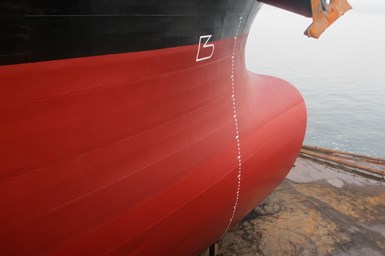PPG Unveils Copper-Free Antifouling Coating
Nexeon 810 surface technology delivers emissions savings.
Edited by Hannah Zelinski
PPG has launched its Nexeon 810 coating, a copper-free antifoulant developed with an emphasis on vessel performance, emissions reduction and sustainability. The company claims that the surface of the coating can yield a boost in power and enhance operational efficiency because of improved fouling control performance, depending on the vessel and operating conditions.
Furthermore, the company asserts that using Nexeon 810 coating reduces fuel consumption and lowers greenhouse gas (GHG) emissions, enabling a vessel to sustain higher speeds while helping vessel owners and operators remain compliant with the carbon intensity indicator (CII) requirements of the International Maritime Organization (IMO). The coating’s formula can reportedly achieve a total reduction of up to 25% in GHG emissions compared to traditional antifouling coatings and supports 60 days of idle time resistance with minimal speed loss.
The coating is designed to offer controlled and predictable solubility, to promote strong performance throughout the vessel’s operational period. The coating is also suitable for electrostatic application and offers color retention throughout the service life of the vessel.
“PPG Nexeon 810 coating provides the ultimate combination of advanced coatings technology with improved vessel performance and responsible environmental protection,” says Joanna van Helmond, PPG global product manager, antifoulants, protective and marine coatings. “Thanks to PPG’s sustainably advantaged product development process, our customers can enjoy easier application and improved coating performance across the operating life of their vessels.”
The copper-free technology in Nexeon 810 coating is characterized by a reduced biocide content. PPG says its binder technology enables the gradual release and operation of the biocides near the surface, and upon entering the water, the combined effects of sunlight and ocean bacteria kickstart the breakdown of these organic biocides.
The potential for electrostatic application is a significant benefit that the company says is not available in conventional antifouling coatings. The transfer efficiency achieved through electrostatic spraying reportedly provides a uniform film as well as a decrease in overspray and waste, resulting in a reduction in paint consumption and improved health and safety benefits when compared to airless spraying.
RELATED CONTENT
-
Understanding Paint Atomization
BASF coatings development expert Tim December explains how paint atomization works for both pneumatic spray applicators and high-speed rotary bell applicators.
-
Coating Thickness Measurement: The Fundamentals
A review of available test methods, common applications and innovative instrumentation...
-
Paint Application Methods
An overview of spraying, dipping, flow coating, and everything in between.















